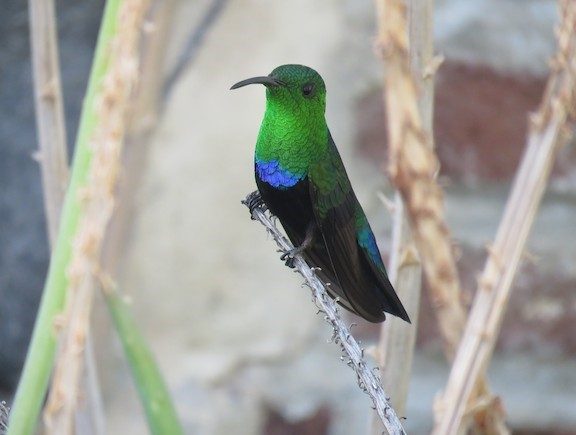Birdfinding.info ⇒ The commonest hummingbird across most of its range, especially at low elevations. Most visitors to the Virgin Islands and Lesser Antilles will find it with no effort, often in the gardens of their hotels. On Puerto Rico, it is fairly common in eastern coastal lowlands west to San Juan on the north coast and to Guayama on the south coast. Consistent sites include Fajardo and Humacao Natural Reserve.
Green-throated Carib
Eulampis holosericeus
Endemic to islands of the eastern Caribbean, from Puerto Rico east and south to Barbados and Grenada. Occurs in a wide variety of habits, including humid and dry forests, open woodlands, scrub, and urban gardens.
Over the course of many decades, the Green-throated Carib has gradually expanded westward across the Virgin Islands, Vieques, Culebra, and the coastal lowlands of Puerto Rico, apparently displacing the Puerto Rican Mango.
Identification
A medium-to-large hummingbird with a decurved bill. Mostly green overall, with a black belly, blue-black tail, blue crescent on the chest, and bluish highlights on rump and vent.
In good light, the green throat and blue crescent on the chest gleam vividly, and the upperparts vary from green to coppery on the back and shoulders, and turquoise on the rump.

Green-throated Carib. (Humacao Natural Reserve, Puerto Rico; January 26, 2008.) © Patrick V.
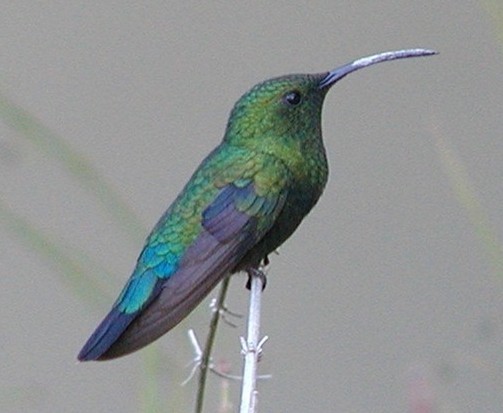
Green-throated Carib, showing mostly green upperparts, with a resemblance to Green Mango—and identified as such by the photographer. (El Morro, Old San Juan, Puerto Rico; November 1, 2002.) © Kathryn Hart
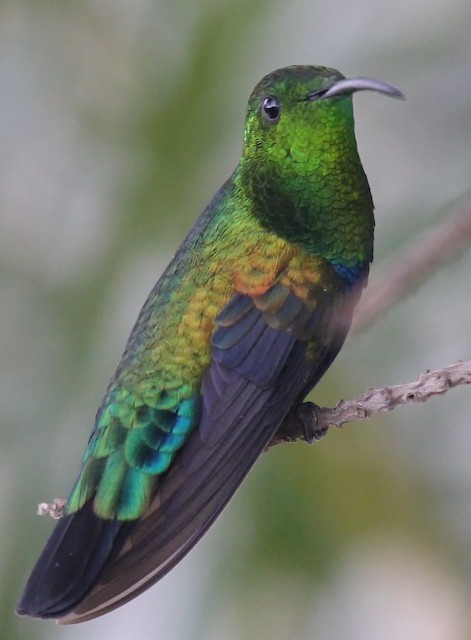
Green-throated Carib, showing coppery and blue highlights on its upperparts. (St. Peter Mountain, St. Thomas, U.S. Virgin Islands; July 13, 2013.) © Tom Kaestner
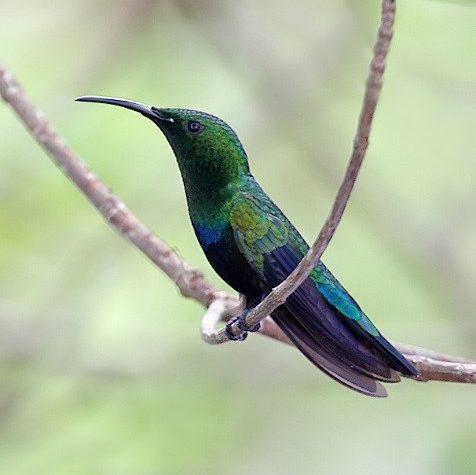
Green-throated Carib. (Parque Central, San Juan, Puerto Rico; February 3, 2010.) © Steve Metz
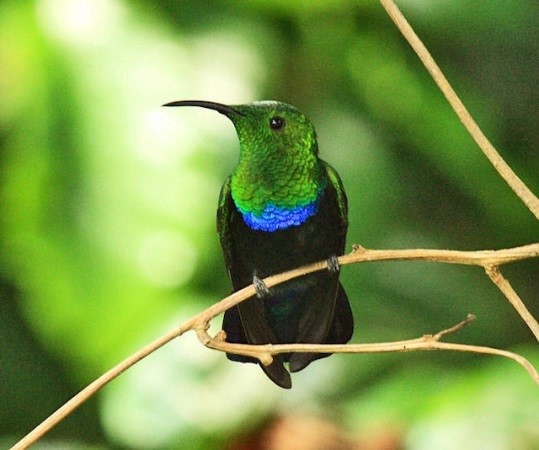
Green-throated Carib, showing the characteristic blue crescent on its chest. (Morne Diablotin National Park, Dominica; October 23, 2009.) © Tom Murray
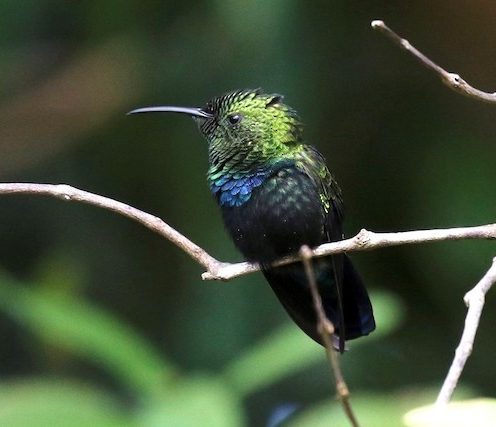
Green-throated Carib. (Soufrière, St. Lucia; December 23, 2016.) © Knut Hansen
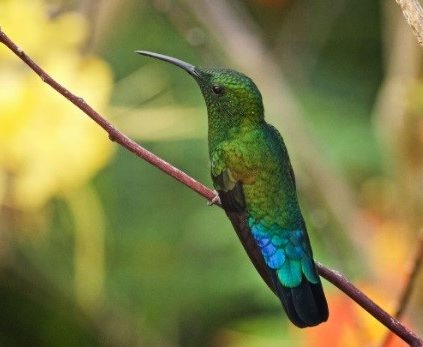
Green-throated Carib, showing coppery and blue highlights on its upperparts. (Ffreyes Beach, Antigua; December 9, 2014.) © Ronsphotos
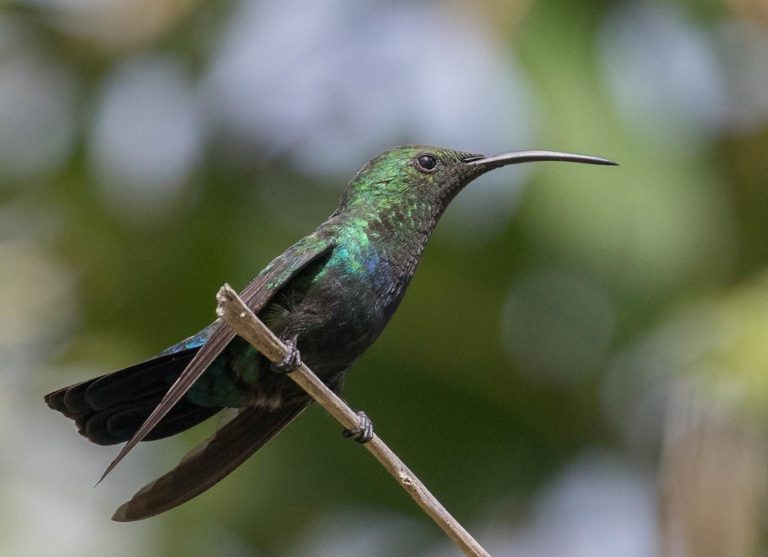
Green-throated Carib, appearing mostly dark green in this lighting. (Fort James Beach, Antigua; April 17, 2018.) © Harold Moses
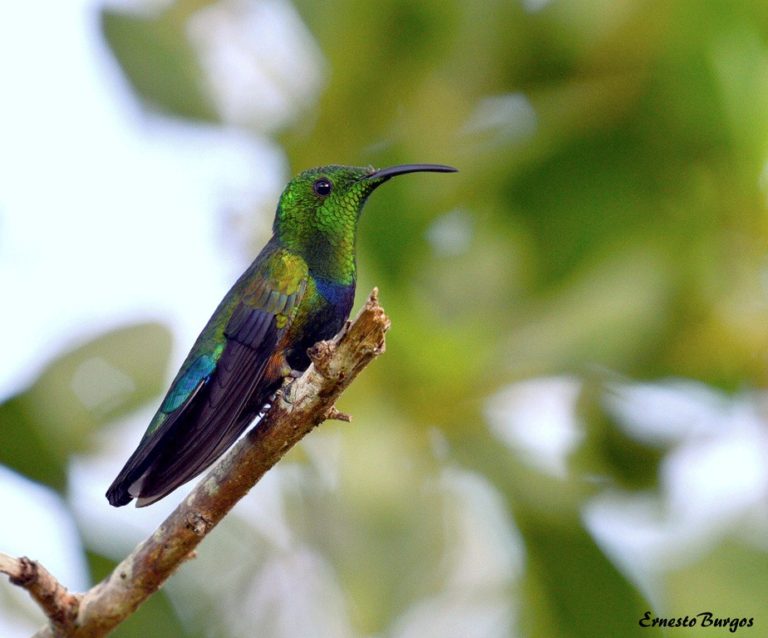
Green-throated Carib, appearing multicolored in this lighting. (Puerto Rico; April 17, 2016.) © Ernesto Burgos

Green-throated Carib, with background of bougainvillea blossoms. (Vieques; March 19, 2012.) © Paul A. Guris

Green-throated Carib, showing coppery and blue highlights on its upperparts. (St. Maarten; March 24, 2017.) © Chris de Visser

Green-throated Carib, showing mostly greenish upperparts. (Luquillo, Puerto Rico; October 20, 2017.) © Carmen R. Mojico Rosario
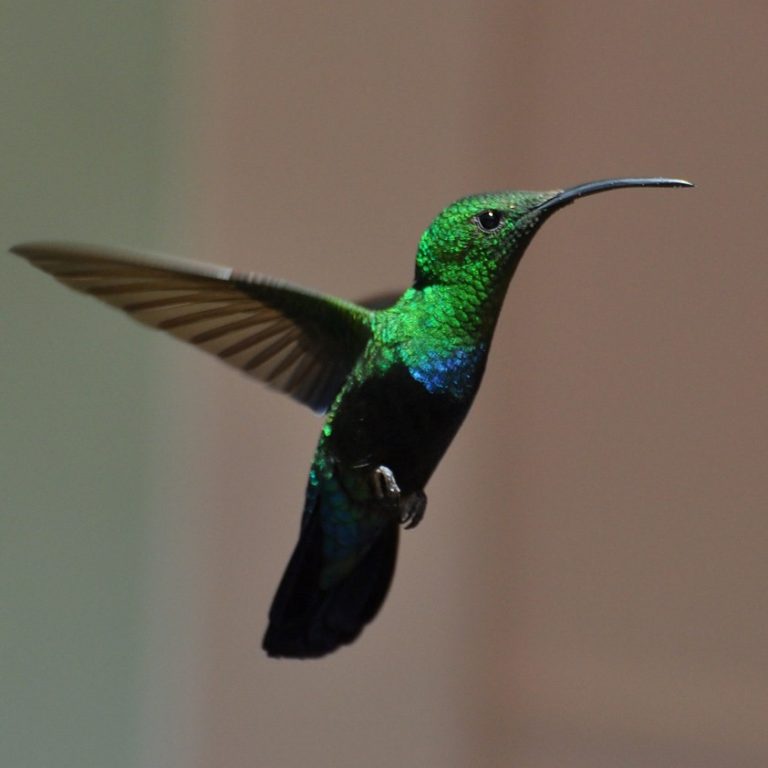
Green-throated Carib. (Bel Event, St. Pierre, Martinique; January 31, 2011.) © Philippe Boissel
Cf. Purple-throated Carib. From Saba to Grenada, the two caribs regularly occur together. They are of similar size and shape, so can easily be confused under poor lighting conditions. In decent lighting, their coloration appears entirely different.
Cf. Green Mango. Under some conditions, Green-throated Carib and Green Mango can appear very similar. They regularly occur within a few miles of each other in eastern Puerto Rico, but are rarely found at the same locations due to their differing habitat preferences—with the mango occupying more humid habitats at higher elevations.
The carib has a more strongly curved bill and usually shows distinctive color contrasts on the underparts: bright green on the throat and upper breast, a bluish breastband, blue-green rump, and blackish lower breast and belly. However, these contrasts can be inconspicuous at times and Green Mango sometimes also shows bluish highlights and a dark belly.
Cf. Puerto Rican Mango. Green-throated Carib appears to be displacing Puerto Rican Mango from eastern Puerto Rico and Culebra, and has likely already replaced it on Vieques and the Virgin Islands. The carib is similar to the mango, but it has a more strongly curved bill, the green of its throat extends farther onto the breast, and its tail is blue-black rather than coppery. The main areas of range overlap are the San Juan area and the eastern lowlands, but the two species could potentially occur together anywhere on Puerto Rico and the Virgin Islands.
Notes
Polytypic species consisting of two recognized subspecies: chlorolaemus on Grenada and holosericeus elsewhere.
References
eBird. 2019. eBird: An online database of bird distribution and abundance. Cornell Lab of Ornithology, Ithaca, N.Y. http://www.ebird.org. (Accessed April 27, 2019.)
Farnsworth, A. 2009. Green-throated Carib (Eulampis holosericeus), version 1.0. In Neotropical Birds Online (T.S. Schulenberg, ed.). Cornell Lab of Ornithology, Ithaca, N.Y. https://doi.org/10.2173/nb.grtcar1.01.
Fogden, M., M. Taylor, and S.L. Williamson. 2014. Hummingbirds: A Life-size Guide to Every Species. HarperCollins, New York.
Raffaele, H. 1989. A Guide to the Birds of Puerto Rico and the Virgin Islands. Princeton University Press, Princeton, N.J.
Raffaele, H., J. Wiley, O. Garrido, A. Keith, and J. Raffaele. 1998. A Guide to the Birds of the West Indies. Princeton University Press, Princeton, N.J.
